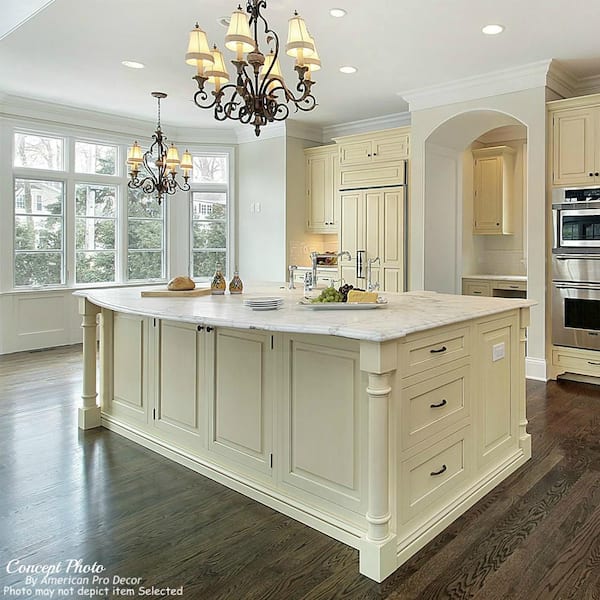Customized Kitchen Island Legs to Suit Your Kitchen Aesthetic
Customized Kitchen Island Legs to Suit Your Kitchen Aesthetic
Blog Article
Vital Tips for Picking the Perfect Table for Your Cooking Area
Picking the perfect table for your cooking area is greater than just an issue of preference; it necessitates a comprehensive understanding of your area and requirements. Begin by determining your readily available space to guarantee enough clearance for movement. The shape of the table plays an essential role; while rectangle-shaped tables fit larger areas, rounded ones foster affection, and extendable options supply adaptability. Product selection is equally essential, with woods giving resilience and glass borrowing a modern touch. The table ought to balance with your kitchen's appearances and accommodate your household conveniently. What various other aspects might influence this important choice?
Measure Your Area
Selecting the optimal dining table begins with a precise evaluation of your readily available space. This foundational step guarantees that the table not just fits comfortably within the space however also matches the total layout and functionality of your eating area.
Take into consideration the flow of movement around the table. It is important to leave appropriate space for chairs to be drawn out and for individuals to move around the table without blockage. A general regulation of thumb is to permit a minimum of 36 inches of clearance from the side of the table to the local wall or furniture piece. This ensures simplicity of access and convenience throughout dishes.
In addition, consider the variety of individuals you typically amuse and whether you require additional room for visitors. Selecting an extendable table can supply flexibility, allowing you to suit differing varieties of diners. By precisely determining your room, you prepared for picking a table that enhances both the appearances and performance of your dining area.
Select the Right Shape

On the other hand, round tables are exceptional for smaller sized kitchens or intimate gatherings, as they advertise discussion by enabling everybody to encounter each other. They also supply a feeling of comfort and can fit well in tighter spaces as a result of their lack of sharp corners. Oblong tables provide the most effective of both globes, integrating the size of rectangular tables with the intimacy of rounded ones, making them flexible for various setups.
Square tables are one more option, specifically suited for square-shaped rooms. They produce a modern and balanced appearance, fostering an equivalent eating experience for all seated. They may be less practical for bigger events unless they come with extensions. Ultimately, the shape you select ought to align with your area measurements and lifestyle to ensure both type and function.
Material Factors To Consider
When picking a dining table, product factors to consider are paramount in determining the table's sturdiness, upkeep requirements, and general aesthetic. Timber is a timeless selection, supplying ageless allure and effectiveness.
Glass-topped tables provide a modern, sleek look and can make an area appear larger due to their openness. They call for frequent cleaning to avoid smudges and finger prints. Additionally, toughened up glass is suggested for its added strength and safety and security.

Lastly, composite products like MDF (Medium-Density Fiber board) or plywood are economical alternatives. These products can imitate check my site the appearance of solid wood however may not provide the same long life. They are usually simpler to clean but can be vulnerable to water damage otherwise effectively secured.
Eventually, the option of material ought to align with your cooking area's design, your way of life needs, and your budget restrictions. (kitchen island legs)
Seats Capability and Convenience
How do you identify the best seats capability and comfort for your eating table? For a household of four, a rectangular table of 48 inches long or a round table with a 48-inch diameter is generally adequate.
The height of the table must preferably be around 30 inches, supplying a well balanced ergonomic position for seated diners. Chairs must have a seat height of 18 to 20 inches to make sure a comfy dining position.
Style and Aesthetic Appeal
Picking a dining table that suits your design and aesthetics involves balancing personal taste with the existing decor of your eating room. The dining table is often the focal point of the kitchen, and its layout should enhance the general theme of the space. Whether your kitchen area flaunts a modern, minimal look or a rustic, farmhouse charm, the table you choose need to balance with these aspects to create a cohesive and inviting environment.
Consider products meticulously; wood offers a timeless allure and can vary from abundant mahogany for a traditional look to lighter oak for a modern feel. Steel and glass tables, on the various other hand, can present a smooth, commercial edge to your kitchen. Do not ignore the table's shape-- rectangular tables are timeless and versatile, while round and oval alternatives can promote an extra intimate dining experience.
Furthermore, pay attention to coatings and details. A troubled coating may add character and heat, whereas a glossy surface area can contribute to a clean, modern aesthetic. Inevitably, your table need to not just healthy seamlessly right content into your cooking area's design but likewise mirror your personal design, elevating the area both functionally and visually.
Conclusion
In verdict, choosing the excellent eating table for a kitchen requires cautious analysis of area, shape, material, seating capability, and aesthetic consistency. Ultimately, a well-chosen dining table fosters an inviting atmosphere and fits the family comfortably, therefore improving the eating experience.

When selecting an eating table, material factors to consider are paramount in figuring out the table's toughness, upkeep needs, and general visual. For a family of 4, a rectangular table of 48 inches long or a round table with a 48-inch size is normally sufficient.
Do not neglect the table's form-- rectangular tables are functional and traditional, while round and oval options can promote a more intimate eating experience. kitchen island legs.
Report this page